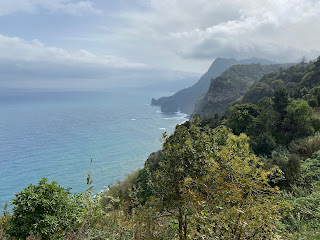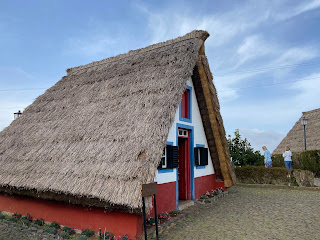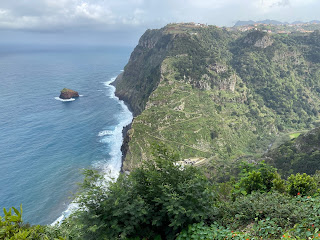Today is a deep dive into José Miguel’s Madeira; José Miguel being Donna’s cousin. They are third cousins - they share great grandparents, as their grandmothers were sisters. We begin the tour at the Igreja de Santo Antótnio. Easily identified by its twin herring-bone tower caps, the church is highly visible from the highway when arriving to west side of Funchal from the airport. We don’t get a close look as the parishioners are in the middle of Sunday mass, but am able to snap a few quick shots. We do our best to inconspicuously inspect the architecture, but this is the church where Donna’s grandparents were married, so we want to also capture something of the place. We certainly don’t want to leave empty-handed.
Now we resume our exploration of the island’s north coast, today going east to west. Our first stop is Porto da Cruz, the small town east of the Penha de Águia - the enormous coastal butte we saw from the “miradouro” on Thursday. Gazing up at the thing makes it more impressive.
Lunch is in the Santana, at the Quinta do Furao. An appealing spot with enchanting scenery, and we eat well: steamed limpets, smoked pork rib, and crispy “milho frito” (fried cubes of corn meal). The area is know for the traditional thatched-roof, A-frame houses, and we see quite a few scattered about town.
In Santana’s town center there is a little cluster of these houses that the city uses attract tourists and offer some education. I appreciate the way the thatch is bundled and layered, and tied with reeds. The wood joints are intriguing, too, as the ‘loft’ joists are pegged without a shoulder on the rafters, just a lap joint. Across the street is a plaza and street market where local fruits and vegetables are sold. Some of the fruits look quite exotic; José Miguel buys us something. I still am not sure what it is (it still sits on our hotel room table).
Next is the village of São Jorge; every other house belongs to a cousin. The parish church is a little gem, with an elaborate altar piece crowned by the figure of São Jorge killing the dragon. Many expressive figures fill the altar. Recently restored, it’s remarkably clean and fresh.
We continue down the road to the cemetery and pay our respects to José Miguel’s family. The views from the nearby “miradouro” are wonderful, with farms atop the cliffs over the sea. Look closely and you can see some of the amazing, switch-back walking paths that the locals still use to get up and down the levels. As we are leaving town, we actually run into and get to meet some of the many cousins (Leandro).
We make our last stop in Faial, the town just to the west of the Penha de Águia. There is a cute, road-side “miradouro” on the highway, at one of the hairpins, with a small, silver Virgin is a case and a few candles. With the setting sun behind us, the Penha looks phenomenal, and I can see there is a ridge there in front, with a natural gateway, and the old bridge just behind.
We peer down at the church, and note the cart-racing track just beyond - such practical urban planning.


























No comments:
Post a Comment